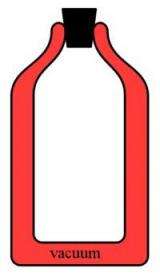December 10, 2009 weblog
Scientists Create Material More Insulating than the Vacuum

(PhysOrg.com) -- With its complete lack of atoms, a vacuum is often considered to be the best known insulator. For this reason, vacuums are regularly used to reduce heat transfer, such as in the lining of a thermos to keep beverages hot or cold. However, in a recent study scientists have found a material even less able to conduct heat: a stack of photonic crystals layered within a vacuum can create a material with a thermal conductance just half that of empty space alone.
Basically, heat can be transferred from one material to another in three main ways: convection, conduction, and radiation. Conduction and convection both require some kind of material medium for heat to pass through; therefore, the lack of material in a pure vacuum greatly minimizes the effectiveness of these two processes. However, heat can also be transferred through infrared radiation, a form of light that is invisible but can be felt as heat. In the example of the thermos, infrared radiation can travel through the vacuum to the thermos' outer wall; when absorbed by the outer wall, the radiation causes the molecules in the outer wall to vibrate and release heat.
Shanhui Fan of Stanford University and his colleagues wondered if any material could block infrared radiation better than a vacuum can. Last year, the scientists theoretically calculated that photonic crystals might be the answer. Photonic crystals, which can be found in nature as well as be created in the lab, consist of periodic bands of nanostructures that affect how light travels through them. Significantly, photonic crystals can have band gaps that forbid propagation of certain frequency ranges of light. In this case, they could be used to block infrared radiation.
The scientists found that a 100-micron-thick structure made of a stack of 10 photonic crystal layers, each 1 μm thick and separated by 90-μm gaps of vacuum, could reduce the thermal conductance to about half that of a pure vacuum. In a more recent study, Fan and his colleagues calculated the fraction of all frequencies that the photonic crystal allows through. They were somewhat surprised to find that the thermal conductance doesn't depend on the thickness of the layers but only on how fast light travels through the material, or its index of refraction.
Photonic crystals have previously been shown to have promising applications in communications and computing, and the new research suggests their thermal properties could make them useful for a variety of other applications. For example, solar-thermal applications that capture the sun's heat for use as an energy source could likely benefit from a material that can allow visible light to pass through, while keeping the heat inside.
More information: W T Lau et al. "Universal features of coherent photonic thermal conductance in multilayer photonic band gap structures." 2009 Phys. Rev. B 80 155135.
• Join PhysOrg.com on Facebook!
• Follow PhysOrg.com on Twitter!
via: Physical Review Focus
© 2009 PhysOrg.com
















